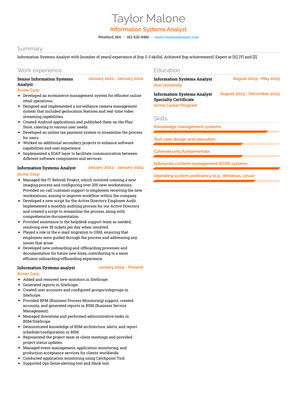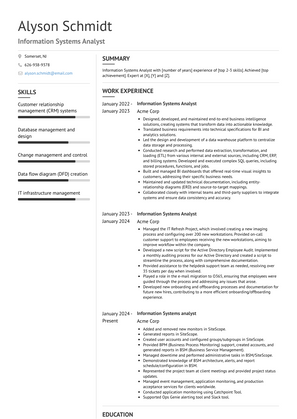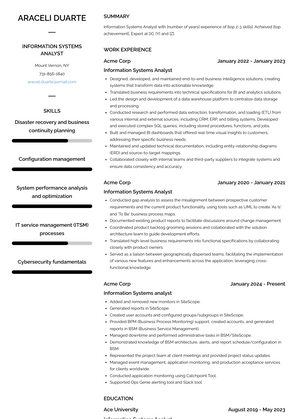Information Systems Analyst Resume Examples and Templates
This page provides you with Information Systems Analyst resume samples to use to create your own resume with our easy-to-use resume builder. Below you'll find our how-to section that will guide you through each section of a Information Systems Analyst resume.



What do Hiring Managers look for in an Information Systems Analyst Resume
- Technical Proficiency: Proficiency in information systems, databases, and relevant technologies.
- Problem-Solving: Ability to analyze complex issues and provide effective solutions.
- Analytical Skills: Skill in data analysis and using data to make informed decisions.
- Communication: Strong verbal and written communication skills for conveying technical information.
- Adaptability: Willingness to learn and adapt to evolving technologies and business needs.
How to Write an Information Systems Analyst Resume?
To write a professional Information Systems Analyst resume, follow these steps:
- Select the right Information Systems Analyst resume template.
- Write a professional summary at the top explaining your Information Systems Analyst’s experience and achievements.
- Follow the STAR method while writing your Information Systems Analyst resume’s work experience. Show what you were responsible for and what you achieved as an Information Systems Analyst.
- List your top Information Systems Analyst skills in a separate skills section.
How to Write Your Information Systems Analyst Resume Header?
Write the perfect Information Systems Analyst resume header by:
- Adding your full name at the top of the header.
- Add a photo to your resume if you are applying for jobs outside of the US. For applying to jobs within the US, avoid adding photo to your resume header.
- Add your current Information Systems Analyst position to the header to show relevance.
- Add your current city, your phone number and a professional email address.
- Finally, add a link to your portfolio to the Information Systems Analyst resume header. If there’s no portfolio link to add, consider adding a link to your LinkedIn profile instead.
Bad Information Systems Analyst Resume Example - Header Section
Mylee 696 Rock Maple St. South Lyon, MI 48178 Marital Status: Married, email: cooldude2022@gmail.com
Good Information Systems Analyst Resume Example - Header Section
Mylee Walters, Lyon, MI, Phone number: +1-555-555-5555, Link: linkedin/in/johndoe
Make sure to add a professional looking email address while writing your resume header. Let’s assume your name is John Doe - here is a formula you can use to create email addresses:
- firstnamelastname@email.com - johndoe@email.com
- firstname.lastname@email.com - john.doe@email.com
- lastname.firstname@email.com - doe.john@email.com
- f.lastname@email.com - j.doe@email.com
- l.firstname@email.com - d.john@email.com
- firstnamelastname12@email.com - johndoe12@email.com
For a Information Systems Analyst email, we recommend you either go with a custom domain name (john@johndoe.com) or select a very reputed email provider (Gmail or Outlook).
How to Write a Professional Information Systems Analyst Resume Summary?
Use this template to write the best Information Systems Analyst resume summary: Information Systems Analyst with [number of years] experience of [top 2-3 skills]. Achieved [top achievement]. Expert at [X], [Y] and [Z].
How to Write an Information Systems Analyst Resume Experience Section?
Here’s how you can write a job winning Information Systems Analyst resume experience section:
- Write your Information Systems Analyst work experience in a reverse chronological order.
- Use bullets instead of paragraphs to explain your Information Systems Analyst work experience.
- While describing your work experience focus on highlighting what you did and the impact you made (you can use numbers to describe your success as a Information Systems Analyst).
- Use action verbs in your bullet points.
Information Systems analyst Resume Example
Information Systems analyst
- Added and removed new monitors in SiteScope.
- Generated reports in SiteScope.
- Created user accounts and configured groups/subgroups in SiteScope.
- Provided BPM (Business Process Monitoring) support, created accounts, and generated reports in BSM (Business Service Management).
- Managed downtime and performed administrative tasks in BSM/SiteScope.
- Demonstrated knowledge of BSM architecture, alerts, and report schedule/configuration in BSM.
- Represented the project team at client meetings and provided project status updates.
- Managed event management, application monitoring, and production acceptance services for clients worldwide.
- Conducted application monitoring using Catchpoint Tool.
- Supported Ops Genie alerting tool and Slack tool.
Information Systems Analyst Resume Example
Information Systems Analyst
- Managed the IT Refresh Project, which involved creating a new imaging process and configuring over 200 new workstations. Provided on-call customer support to employees receiving the new workstations, aiming to improve workflow within the company.
- Developed a new script for the Active Directory Employee Audit. Implemented a monthly auditing process for our Active Directory and created a script to streamline the process, along with comprehensive documentation.
- Provided assistance to the helpdesk support team as needed, resolving over 35 tickets per day when involved.
- Played a role in the e-mail migration to O365, ensuring that employees were guided through the process and addressing any issues that arose.
- Developed new onboarding and offboarding processes and documentation for future new hires, contributing to a more efficient onboarding/offboarding experience.
Information Systems Analyst Resume Example
Information Systems Analyst
- Designed, developed, and maintained end-to-end business intelligence solutions, creating systems that transform data into actionable knowledge.
- Translated business requirements into technical specifications for BI and analytics solutions.
- Led the design and development of a data warehouse platform to centralize data storage and processing.
- Conducted research and performed data extraction, transformation, and loading (ETL) from various internal and external sources, including CRM, ERP, and billing systems. Developed and executed complex SQL queries, including stored procedures, functions, and jobs.
- Built and managed BI dashboards that offered real-time visual insights to customers, addressing their specific business needs.
- Maintained and updated technical documentation, including entity-relationship diagrams (ERD) and source-to-target mappings.
- Collaborated closely with internal teams and third-party suppliers to integrate systems and ensure data consistency and accuracy.
Senior Information Systems Analyst Resume Example
Senior Information Systems Analyst
- Developed an ecommerce management system for efficient online retail operations.
- Designed and implemented a surveillance camera management system that included geolocation features and real-time video streaming capabilities.
- Created Android applications and published them on the Play Store, catering to various user needs.
- Developed an online tax payment system to streamline the process for users.
- Worked on additional secondary projects to enhance software capabilities and user experience.
- Implemented a SOAP layer to facilitate communication between different software components and services.
Information Systems Analyst Resume Example
Information Systems Analyst
- Conducted gap analysis to assess the misalignment between prospective customer requirements and the current product functionality, using tools such as UML to create 'As Is' and 'To Be' business process maps.
- Documented existing product reports to facilitate discussions around change management.
- Coordinated product backlog grooming sessions and collaborated with the solution architecture team to guide development efforts.
- Translated high-level business requirements into functional specifications by collaborating closely with product owners.
- Served as a liaison between geographically dispersed teams, facilitating the implementation of various new features and enhancements across the application, leveraging cross-functional knowledge.
Top Information Systems Analyst Resume Skills for 2023
- Systems analysis and design
- Database management and design
- Data modeling and normalization
- Business process modeling
- Requirements gathering and documentation
- Use case modeling and documentation
- Data flow diagram (DFD) creation
- System architecture design
- System integration planning
- Software development life cycle (SDLC)
- Agile and Scrum methodologies
- System testing and quality assurance
- User acceptance testing (UAT)
- Test case design and execution
- Regression testing
- Defect tracking and reporting
- System documentation and manuals
- Change management and control
- Configuration management
- Workflow automation analysis
- Data analysis and reporting
- SQL database query language
- Data extraction, transformation, and loading (ETL)
- Data warehousing concepts
- Big data and analytics tools (e.g., Hadoop)
- Business intelligence (BI) tools (e.g., Tableau)
- Data visualization and dashboard creation
- Cloud computing and services (e.g., AWS, Azure)
- Virtualization and containerization
- IT infrastructure management
- Network fundamentals and troubleshooting
- Cybersecurity fundamentals
- Information security policies and procedures
- Disaster recovery and business continuity planning
- Enterprise resource planning (ERP) systems
- Customer relationship management (CRM) systems
- Enterprise content management (ECM) systems
- Document management systems (DMS)
- Knowledge management systems
- Collaboration and communication tools (e.g., Microsoft Teams)
- System performance analysis and optimization
- System monitoring and alerting tools
- Operating system proficiency (e.g., Windows, Linux)
- Scripting and automation (e.g., Python, PowerShell)
- IT service management (ITSM) processes
- Help desk and incident management
- ITIL (Information Technology Infrastructure Library)
- IT project management fundamentals
- Software development tools (e.g., IDEs)
- Continuous learning in IT and IS best practices
How Long Should my Information Systems Analyst Resume be?
Your Information Systems Analyst resume length should be less than one or two pages maximum. Unless you have more than 25 years of experience, any resume that’s more than two pages would appear to be too long and risk getting rejected.
On an average, for Information Systems Analyst, we see most resumes have a length of 2. And, that’s why we advise you to keep the resume length appropriate to not get rejected.
Copyright ©2025 Workstory Inc.
